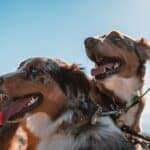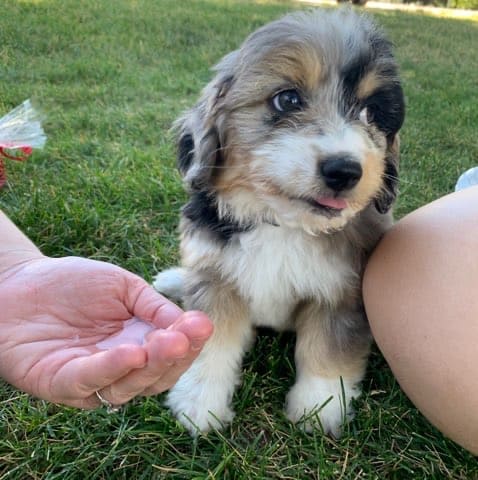Aussie puppies. They are sooo much fun to have around. They love to play, learn and absorb their new environment.
This is a critical stage in the puppy’s development. As the pup is weaned, it will also begin to develop little tiny needles teeth. These little teeth won’t stick around for too long. But they will be crucial for developing so many other behaviors in the dog — most importantly, bite inhibition.
Here’s a quick version of what you can expect:
5-6 Weeks: First Teeth
3 Months: Baby teeth begin to fall out
4 Months: Molars start peeking through
6 Months: Adult teeth will be mostly or fully developed
In this article, you will learn all things “Aussie Teeth.”
You will discover the various stages of growth, what to expect, and what to do if things don’t go as planned. You will also learn about bite inhibition and the importance of socialization during the development stages.

Your Aussie’s First Little Teeth
They are like needles.
You will start seeing the little tiny teeth breaking through the pups gums around the time they begin to wean from milk.
Generally speaking this starts somewhere around the five to six week age. Some puppies don’t begin teething until even eight or nine weeks old. (both of mine fell in the latter category, for what it’s worth).
If all goes as planned you’re gonna see 28 of those little needle teeth. Also called: ‘milk teeth,’ these teeth are sharp like a razor and the Aussie pup equivalent of baby teeth.
Much like with humans, teething is incredibly painful for Australian Shepherd puppies.
Frequently you’ll notice that your pup will start looking for a tasty shoe or item of clothing (usually they’ll go for the most expensive clothing too. They have incredibly good taste for puppies).
The pup will chew on things to relieve some of the pressure that he/she feels in it’s mouth.
(side note: We found that freezing chewing rings helped alleviate the pain for the pup, and also saved the life of a pair of shoes).

What Age Do Australian Shepherds Start to Lose Baby Teeth
Aussie puppies, like most puppies will start to lose their milk teeth faster than it took them to come in.
The little daggers that have been gnawing on your toes will begin falling out approximately one month after coming through. Seems like almost a waste of time for them doesn’t it?
At only 3 months of age, your Aussie puppy will lose her first set of teeth.
The process usually starts with the incisors, usually they will be laying on the ground unexpectedly for you to step on, just like a lego.
Chewing may slow down during the loss period but not necessarily. Every dog is different, as well as their pain level.
What If My Aussie Puppy Swallows A Baby Tooth?
Chances are pretty high that your pup will swallow a tooth or two.
But the good news is…
Swallowing her baby teeth should not cause her any problems.
Most of the time the puppy teeth will wind up falling out when they are chewing on things and you will never wind up finding them. They may be outdoors or scooped up by a vacuum cleaner.
I spoke to my vet about what happens if they pup should swallow their baby teeth and my vet told me that very few cases of a pup becoming ill or injured have ever come into her clinic — and usually there’s something more going on than that. She explained that the teeth are generally so small that they will pass right through the pup undetected.

What Age Do Australian Shepherds Get Molars?
Your Aussie puppy will start to show signs of adult molars at around four months old. For the most part, the puppy will be all gums by this point — meaning most of those little puppy teeth will be laying around the house and not in the pups mouth anymore.
It is recommended that you take your pup for a vet visit to determine how many more baby teeth may be present. They will also check to make sure everything is coming in properly.
Australian Shepherd Puppy Teeth At Six Months
Around the time of the puppy’s six month birthday party you should have nearly all of the adult teeth solidly in place. If they aren’t all the way in, they will be ¾ at least.
If you notice that any of the puppy’s adult teeth are:
- Coming in crooked
- Growing in a way that may cause the dog eating issues
- Going in a direction that could cause the dog pain Teeth that are growing in crooked or causing the dog to have an overbite may need to be corrected before the teething process is completed.
Correcting the teeth at this stage ensures no long-lasting damage is done. Untreated teeth could make it difficult for the dog to eat later down the road.
How Many Teeth Do Australian Shepherds Have?
Well, are you ready for the good news?
By now, your pup’s teething agony should be pretty well behind him.
Around 8 months old, your dog should have all of his permanent teeth.
42 ‘teeths’ to be exact.
Hopefully by this time you’ve been working with your pup on what is appropriate to chew on and what is not. Those big new teeth might not be as pointy, but they’re BIGGER and there’s double the amount…sooo, the damage has only just begun if you have a chewer.
Throughout the teething process, it is important to provide acceptable objects for chewing on. Make sure to use toys specifically created to help with the teething process. Anti-chew bitter spray does a great job of stopping puppies (and big dogs) from anhilitating another pair of shoes or a table leg.
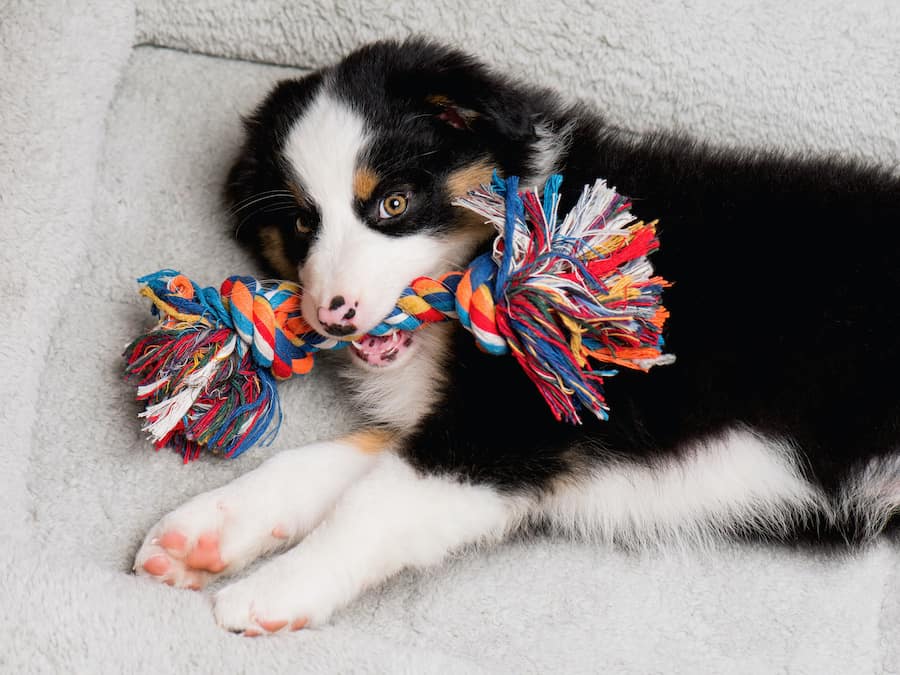
Teaching Your Aussie Bite Inhibition
Your Australian Shepherd must learn to be gentle with all people and animals. As your dog matures they need to understand that those big teeth that they just grew are powered by very strong jaws that can clamp down and do serious damage (even if they didn’t mean too).
That makes the bite inhibition the most important and crucial lesson that your Aussie needs to learn and fully understand.
Teaching your Aussie the importance of developing a soft mouth has a narrow time frame — starting at around 4 ½ months — right when the pup starts getting those big canine teeth.
Your new puppy will be eager to try those new chompers out — making this the IDEAL time for your Aussie to learn bite inhibition. Giving them the proper outlet and way of learning is crucial at this time. It is recommended that pup at this stage get enrolled into puppy classes to help teach him (and you) about bite inhibition.

So, What is Bite Inhibition?
Bite Inhibition as defined on Wikipedia: “Sometimes referred to as a soft mouth, is a behavior in carnivorans whereby the animal learns to moderate the strength of its bite. It is an important factor in the socialization of pets.”
Properly teaching bite inhibition does not mean that you will stop your puppy from biting all together. It means that the dog needs to learn to stop the force behind the bite so they will no longer potentially harm you or anyone/anything else. In order for the puppy to learn how hard is too hard, the puppy DOES need to bite…in order to learn bite inhibition.
All Australian Shepherd puppies bite…that is completely normal (and necessary). You’ll notice that the puppy ‘play bites’ when you spend time with him. Again, this is completely normal and important in order for the puppy to develop bite inhibition and the ‘soft mouth.’
The key to this is feedback
The key to this is feedback that you give your puppy when it does bite. The more feedback you give to your pup, the safer those big ol chompers will be as the dog matures into its adult life. Puppy biting is a normal, natural, and necessary puppy behavior.
Again, you WANT your puppy to bite so you can teach the pup what is acceptable and what is not. A puppy that is not allowed to mouth, nip and bite will be the adult dog that isn’t aware of its ability to cause serious damage…
As your Aussie tests to see what it can get away with, you can expect numerous ‘play’ or ‘test’ bites. They may be somewhat painful since those puppy teeth are like little razors – but luckily those jaws aren’t strong enough yet to do any real harm (they will be though!).
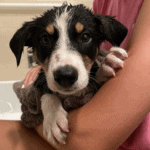
Ouch!
As the puppy grows and gets older he needs to learn and understand that his bites can hurt. Teaching him this will be SO much easier if you do it while he’s young before the jaws catch up to his ability.
The best way to teach them is to give the little fella plenty of opportunity to play bite with other people and other dogs. He will develop a much better feel for bite inhibition when he’s older if you start working on this as soon as possible.
When proper bite inhibition is developed it is unlikely that your dog will be a “biter.” But even if for some reason the dog is pushed to the stage that it bites – the bite inhibition you’ve taught your dog since it was a pup will make the bite generally much less forceful.
If your dog is biting to the point where he’s breaking skin and causing deep puncture-style wounds, rehabilitation of the dog will be much more difficult.
Australian Shepherd Bite Inhibition with Other Dogs
If you’ve ever been around dogs that are ‘play-fighting,’ you’ve seen bite inhibition in full effect.
The dogs roll and tumble, growl, snarl, bark, bite…yet they don’t stop. They continue to fight until *YELP* … that is the sound of bite inhibition being over stepped.
While the dogs might have sounded like they were in a rough n tumble all out war with each other, for the most part what you were seeing isn’t actually what they were feeling. If it was, the dominant dog would’ve ended the fight much earlier.
The dogs are engaged in play fighting and what seemed overly aggressive to us humans, is just good natured fun for the dogs. The biting you witnessed is causing no harm (or at least very little) because of the Aussie’s bite inhibition. You’ll notice after the fight, other than having a wet neck, there aren’t bite marks or any other signs of harm.
The dogs have taught each other bite inhibition and they allow each other to ‘call the shots’ so-to-speak on how much pressure is OK and what isn’t. Your puppy will gather with others and they will teach each other bite inhibition when play-fighting.
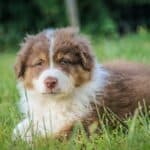
One note about socializing and play fighting with other dogs/puppies…
Be sure that the other dog/pup is vaccinated. Your pup still has a pretty fresh immune system and rough housing around with slobber and anything else has a ton of germs attached to their favorite sport of play fighting.
If you don’t have a vaccinated dog to train the puppy with, you will need to work with the pup on your own until he/she is old enough to begin taking puppy classes where there will be playmates. Bite inhibition needs to be taken seriously. You cannot get started early enough with this process.
Australian Shepherd Bite Inhibition with People
Even if your puppy has a couple of canine buddies at home, you will still need to teach your puppy to inhibit the force and frequency of his bites toward people. Additionally, you must teach your puppy how to react when frightened or hurt by people. He should by all means yelp, but he should not bite and he should never bear down.
Even if your dog is friendly and mouths gently, by five months of age at the very latest, he must be taught never to touch any person’s body or clothing with his jaws unless requested. Whereas mouthing is essential for puppies and acceptable from a young adolescent dog, it would be utterly inappropriate for an older adolescent or adult dog to mouth visitors and strangers.
It would be absolutely unacceptable for a six-month-old dog to approach a child and take hold of her arm, no matter how gentle, friendly, and playful the dog’s intentions. It would frighten the living daylights out of the child, to say nothing of her parents.

Puppies ARE going to bite
Remember that they have a lot of energy and are very curious.
It is important to let them test the waters but they need to learn “how hard is too hard” and that they cannot bite humans or other animals because this can hurt the person or animal.
It is important that the puppy learns how to react when it is frightened or hurt. The pup should learn that it’s OK to yelp; however, reacting with a hard bite is unacceptable.
When people are around, give your pup something else to do.
They love to chew on toys or play with another dog. If someone approaches him, make sure he doesn’t jump on them. Call out his name so he knows it’s okay for him to come closer. This will teach him how close is safe and appropriate when meeting new people.
The most important thing about training a puppy is that you always need to be aware of their behavior. They will constantly test you and their friends. Do NOT let them gain the control in this situation.
It is completely unacceptable for an adult dog to do things with it’s mouth that a 3-month pup does. The dog needs to learn that it CANNOT ever touch a person’s body with his jaws. Unless you have asked him to do so.

What If My Aussie Puppy Doesn’t Bite?
It’s possible you have a pup that is on the shy side. Although, for Australian Shepherds, this is pretty uncommon…but it’s possible.
A shy puppy will tend to hang out more on its own. The pup will spend less time in social settings, rough-housing with other dogs. Because of this, the pup will have less opportunity to develop their bite inhibition skills. They will not learn to limit the power behind their jaws.
This type of behavior leads to the situation of a dog who “has never been aggressive” suddenly lashing out. Usually at a person or another dog. Over something they shouldn’t have lashed out at. This can happen years later even.
If you have a shy puppy, it’s VERY important to try to get it socialized as much as possible. Interacting with as many strange new things will help the puppy learn that not everything is an ‘attack.’
Puppy Classes
Aussie’s (and most other herding animals) develop quicker than most dogs. Puppy classes suggest starting at around 4 ½ months for most breeds. But…Australian Shepherd’s need to start at 3 ½ months. 4 ½ months is too late for their fast growing minds.
You will find tremendous benefits to taking a puppy class at 3 ½ months. Signing up for another class a month or two down the road is recommended highly for Australian Shepherd puppies. Doubling up on classes is a great way to develop and lock-in their socialization skills.


